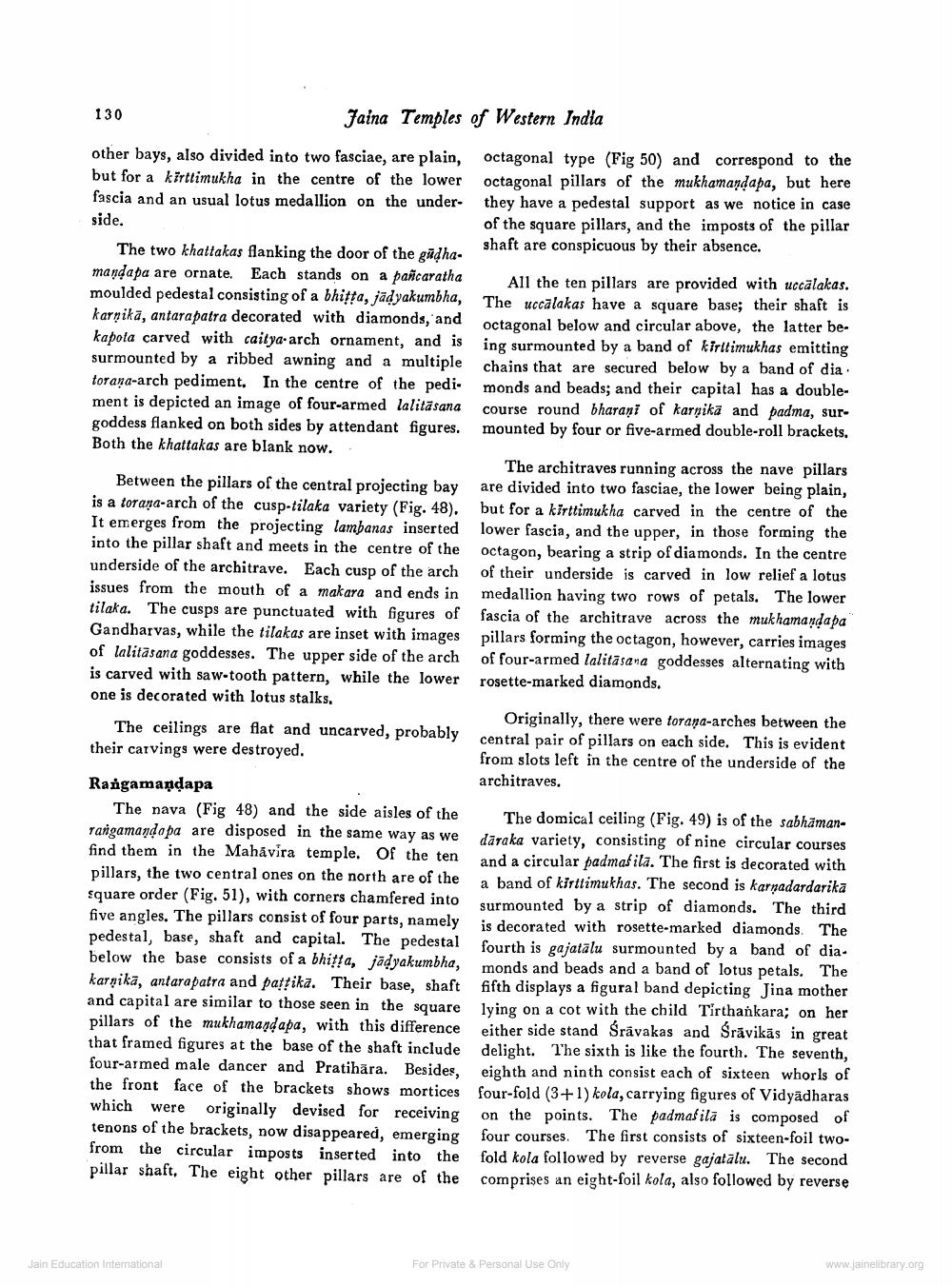________________
130
Faina Temples of Western India
other bays, also divided into two fasciae, are plain, octagonal type (Fig 50) and correspond to the but for a kürttimukha in the centre of the lower octagonal pillars of the mukhamandapa, but here fascia and an usual lotus medallion on the under they have a pedestal support as we notice in case side.
of the square pillars, and the imposts of the pillar
shaft are conspicuous by their absence. The two khattakas flanking the door of the gūdha. mandapa are ornate. Each stands on a pancaratha All the ten pillars are provided with uccalakas. moulded pedestal consisting of a bhitta, jadyakumbha, The uccalakas have a square base; their shaft is karnika, antara patra decorated with diamonds, and
octagonal below and circular above, the latter bekapota carved with caitya-arch ornament, and is ing surmounted by a band of kiritimukhas emitting surmounted by a ribbed awning and a multiple chains that are secured below by a band of dia. torana-arch pediment. In the centre of the pedi- monds and beads; and their capital has a doublement is depicted an image of four-armed lalita sana course round bharani of karnika and padma, surgoddess flanked on both sides by attendant figures. mounted by four or five-armed double-roll brackets. Both the khattakas are blank now..
The architraves running across the nave pillars Between the pillars of the central projecting bay are divided into two fasciae, the lower being plain, is a torana-arch of the cusp-tilaka variety (Fig. 48). but for a kirttimukha carved in the centre of the It emerges from the projecting lambanas inserted lower fascin, and the upper, in those forming the into the pillar shaft and meets in the centre of the octagon, bearing a strip of diamonds. In the centre underside of the architrave. Each cusp of the arch of their underside is carved in low relief a lotus issues from the mouth of a makara and ends in medallion having two rows of petals. The lower tilaka. The cusps are punctuated with figures of fascia of the architrave across the mukhamandapa Gandharvas, while the tilakas are inset with images pillars forming the octagon, however, carries images of lalitasana goddesses. The upper side of the arch of four-armed lalitasana goddesses alternating with is carved with saw-tooth pattern, while the lower rosette-marked diamonds. one is decorated with lotus stalks.
Originally, there were torama-arches between the The ceilings are flat and uncarved, probably
nd uncarved, probably central pair of pillars on each side. This is evident their carvings were destroyed.
from slots left in the centre of the underside of the
architraves. Rangamaņdapa
The nava (Fig 48) and the side aisles of the The domical ceiling (Fig. 49) is of the sabhamanTarigamanda pa are disposed in the same way as we daraka variety, consisting of nine circular courses find them in the Mahavira temple. Of the ten and a circular padmašila. The first is decorated with pillars, the two central ones on the north are of the a band of kirttimukhas. The second is karnadardarika square order (Fig. 51), with corners chamfered into surmounted by a strip of diamonds. The third five angles. The pillars consist of four parts, namely is decorated with rosette-marked diamonds. The pedestal, base, shaft and capital. The pedestal fourth is pajatalu surmounted by a band of dia. below the base consists of a bhitta, jädyakumbha, monds and beads and a band of lotus petals. The karpika, antarapatra and paffika. Their base, shaft fifth displays a figural band depicting Jina mother and capital are similar to those seen in the square lying on a cot with the child Tirthankara; on her pillars of the mukhamaqdapa, with this difference either side stand Srävakas and Srāvikās in great that framed figures at the base of the shaft include delight. The sixth is like the fourth. The seventh, four-armed male dancer and Pratihära. Besides, eighth and ninth consist each of sixteen whorls of the front face of the brackets shows mortices four-fold (3+1) kola, carrying figures of Vidyadharas which were originally devised for receiving on the points. The padmašila is composed of tenons of the brackets, pow disappeared, emerging four courses. The first consists of sixteen-foil twofrom the circular imposts inserted into the fold kola followed by reverse gajatālu. The second pillar shaft, The eight other pillars are of the comprises an eight-foil kola, also followed by reverse
For Private & Personal Use Only
Jain Education Interational
www.jainelibrary.org




